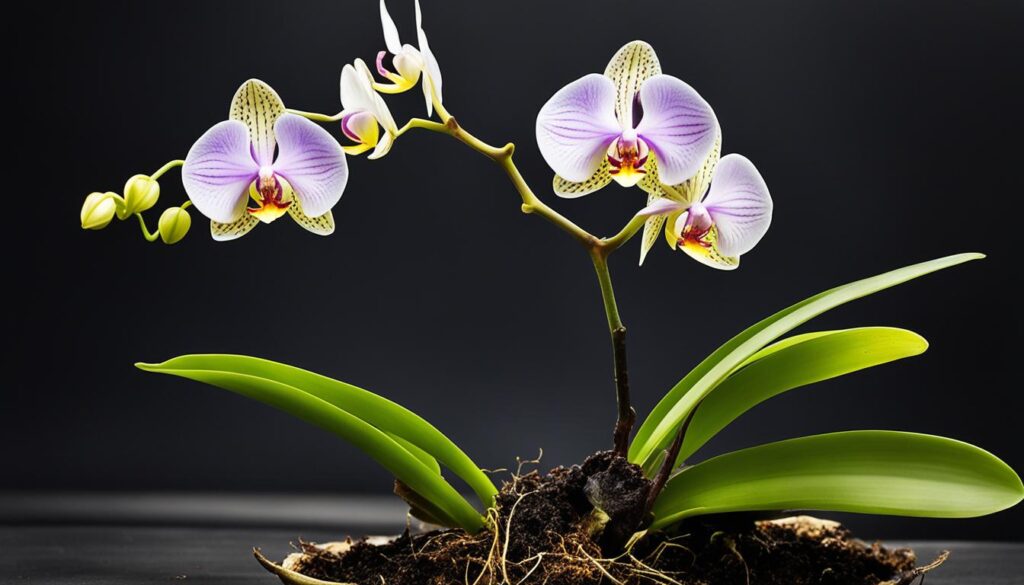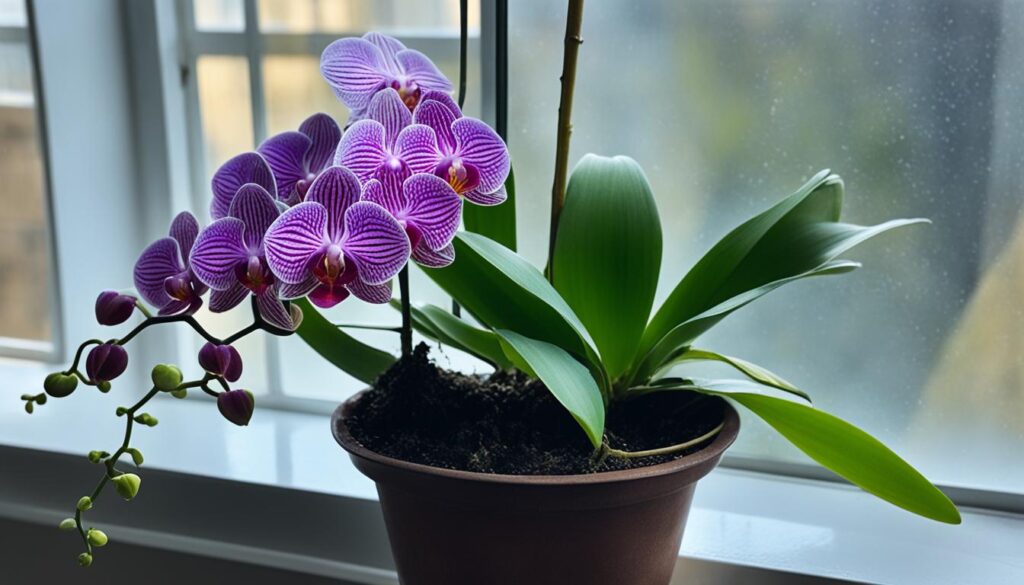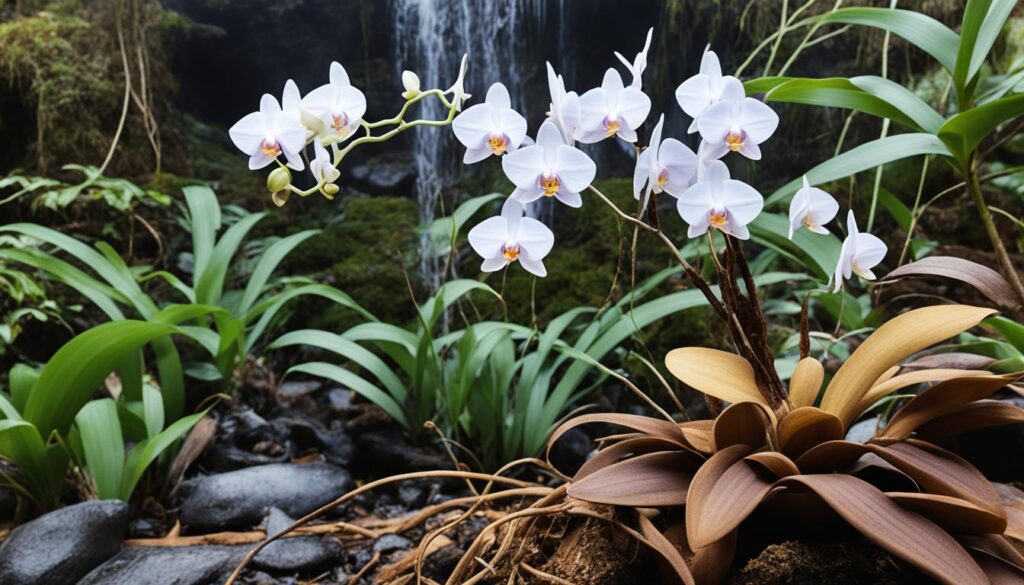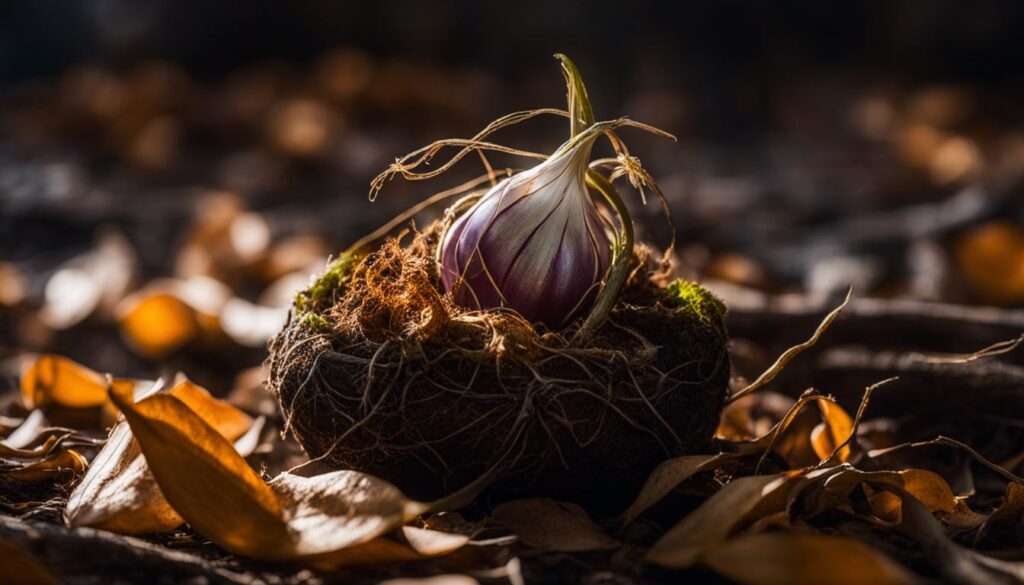As an orchid enthusiast, I’ve observed the intriguing cycle of orchid dormancy firsthand.
The winter dormancy for orchids can be perplexing to new growers, resembling a period of stagnation or even decline.
Yet, this phase is akin to a deep slumber during which the orchid musters its strength for the forthcoming bloom season. Recognizing the signals and strategies for optimal orchid dormancy care is paramount for fostering a robust comeback.
Whether nurturing a Max & Miles Phalaenopsis or another species, understanding and embracing this lull is crucial for the health and splendor of these beloved plants.
Key Takeaways
- Orchid dormancy is a natural, restorative phase crucial for healthy blooms.
- Creating a cooler environment simulates natural winter conditions.
- Reduced watering and fertilization are key aspects of orchid dormancy care.
- Bloom loss is a normal part of the dormancy cycle, not a cause for concern.
- Preparing your orchid during this time encourages a vibrant future bloom cycle.
- Understanding the dormancy period dispels the unease around seasonal changes in orchids.
Introduction to Orchid Dormancy
For many gardening enthusiasts and orchid lovers, understanding orchid dormancy is fundamental to nurturing these fascinating plants through their natural life cycles.
The orchid dormancy period is a span of time when these delicate plants retreat into a state of rest, which can last between six to nine months. Recognizing the signs of orchid dormancy is crucial to ensure that our cherished orchids are merely resting and not in distress.
During this phase, they conserve energy and embark on preparations for their next flourishing season of blooms.
- In the stillness of dormancy, orchids are not stagnant; they are making pivotal preparations for a vibrant future.
- The cessation of blooms does not equate to the end of beauty, but rather, a necessary interlude for rejuvenation.
- As orchid enthusiasts, our role is to replicate the natural triggers for dormancy and provide conditions for recovery and growth.
Below is a table that outlines some key indicators of orchid dormancy, helping to distinguish this natural phase from potential health issues that may require different care strategies:
| Sign | Description | Common During Dormancy | Potential Sign of Health Issue |
|---|---|---|---|
| Bloom Loss | Fading and dropping of the orchid’s flowers | Yes | No |
| Leaf Texture | Leaves might appear flatter and more limp, but still maintain a healthy green color | Yes | If discoloration occurs |
| Stem Changes | Stems may begin to dry, but stay intact and may turn silver in color | Yes | If stem begins to rot or excessively shrivel |
| New Growths | Slowdown or pause in new leaves or roots | Yes | If no new growths after an extended period |
As we continue to nurture our orchids through their dormancy, patience and attentiveness are our best tools.
By providing the right balance of care, we can all enjoy the return of our orchids’ stunning blooms, highlighting the reward of our dedication to these unique plants.
Demystifying Orchid Dormancy: Bloom Loss Isn’t The End
As an orchid enthusiast, I’ve learned that the phenomenon of orchid dormancy can often be mistaken for the end of a plant’s lifecycle.
However, through careful observation and understanding of this natural process, it becomes clear that this is simply a pause, a time for the orchid to gather its strength for future blooming.
Let’s dive deeper into what orchid dormancy entails and how we can manage this important stage.
What Does Orchid Dormancy Look Like?
When my orchids enter dormancy, the vibrant blooms that once graced my space wither and fall away. Regardless of the species, the common denominator is a plant at rest.
The lush, firm stems often dry out and the very leaves that stood rigid and bright may now hang limply, exuding an air of lethargy.
Yet, such signs are not cause for alarm; they are mere indicators of this rest phase. By teetering on the verge of inducing orchid dormancy purposefully or preventing it inadvertently, I’ve understood the balance required in nurturing these plants during their dormancy.
Properly navigating this phase is a dance with nature, one that ensures the vitality of the orchids through their cycle of rest and revival.

The Rhythmic Cycle of Flowering and Resting
Looking at the natural world, orchid dormancy is but a reflection of the rhythmic cycle many plants undergo.
Resembling the habits of outdoor specimens that bloom profusely in the sunshine of spring and summer, then hunker down during the chill of fall and winter, indoor orchids require us to be the conductor of their environmental conditions.
By modulating factors like temperature, light, and watering, I play a pivotal role in either breaking orchid dormancy when the time is right or preventing an untimely dormancy that may disrupt the orchid’s growth.
Orchid enthusiasts can replicate these external cues indoors to encourage or forestall this dormancy period. It’s in my power to recreate the essence of the seasons, guiding my orchids through their cycles of sleep and splendor.
Understanding and embracing the dormancy phase can transform it from an instance of concern to a moment of anticipation.
Acknowledging that this state is a precursor to rejuvenation rather than a conclusion empowers us to foster our orchids through their slumber.
And when we have learned how to induce orchid dormancy effectively, we have harnessed the ability to coax the plant back to its former glory, replete with exquisite blooms and resplendent leaves.
Discovering the Quiet Season: Signs of Orchid Dormancy
As an orchid enthusiast, it’s essential for me to understand the distinction between a dormant orchid and one that’s in distress.
One of the most frequently asked questions I encounter is: is my orchid dormant? To answer that, there are certain orchid dormancy signs you can look for, especially in dormancy in Phalaenopsis orchids, often known as “Phals”.
Let’s delve into the visual indicators that suggest your orchid is simply taking a well-deserved rest.
Visual Indicators of Dormancy in Phalaenopsis Orchids
When detecting the onset of dormancy, I pay close attention to the leaves: their texture and posture can tell you a lot.
Floppy and less glossy leaves are typically the orchid’s approach to conserving resources.
This doesn’t necessarily mean poor health but rather is a natural response to the cooler, less active growth period.
A clear tip-off is the bloom life cycle. If your orchid’s flowers are dropping, don’t panic, this is an obvious sign of dormancy.
The orchid is simply following its natural cycle, shedding old blooms to conserve energy for the next flowering period.
Navigating the Dormancy Diagnosis: Is My Orchid Asleep or Unwell?
It’s crucial to make a proper diagnosis when it comes to orchid health. Leaf loss, a symptom not typically associated with dormancy in Phalaenopsis orchids, may indicate a different issue.
To alleviate any concerns, I’ve created a comparison to guide you through the signs of dormancy versus symptoms that warrant further inspection.
| Sign/Symptom | Indication of Dormancy | Possible Health Issue |
|---|---|---|
| Leaf Texture | Floppy and less glossy | Extremely soft or mushy |
| Leaf Appearance | Leaves flat but intact | Loss of leaves or black spots |
| Bloom Descent | Normal dropping of blooms | Flower spike discoloration or wilt |
| Root Condition | Roots are firm and white/green | Roots are brown and mushy |
Understanding these differences allows me to take the appropriate steps, either letting my orchid enjoy its dormant phase or taking action to address health issues.

Identifying dormancy in orchids need not be complicated. Armed with the knowledge of these signs, you can provide your Phalaenopsis with the care it needs to navigate its quiet season successfully and return with a robust bloom cycle.
Orchid Dormancy Care: Fostering a Healthy Slumber
When my orchids enter their dormant phase, I often remind myself that this is a time for rejuvenation and preparation for future blooms.
Proper orchid dormancy care is critical for the health and reblooming potential of these exquisite plants.
It’s all about recreating conditions similar to their natural habitats during dormancy, which promotes their spectacular blossoms in due time.
The Crucial Role of Water and Light Adjustment
Watering routines need to pivot during this phase. I reduce the frequency to allow the orchid’s roots to dry out more between watering sessions. This mimics the orchid’s natural environment where rain becomes less frequent.
In addition to water adjustments, light plays a pivotal role. Dimming the lights to replicate the shorter days of tropical winter helps signal to the orchid that it’s time to rest.

Continued Care: Fertilization and Temperature Control
Even as my orchids rest, continued care is essential. Fertilization should be continued but at a reduced strength, normally half of what is used during the active growth period.
This sustains the orchid without overstimulating it. Temperature control is another facet of orchid dormancy care I pay close attention to, ensuring the environment is cool but not cold.
| Care Aspect | Active Growth | Dormancy |
|---|---|---|
| Watering | Regular | Reduced |
| Light | Bright, indirect sunlight | Dimmed, fewer hours |
| Fertilization | Full strength | Half strength |
| Temperature | Warm | Cool |
Adhering to this tailored approach for orchid dormancy care, I’ve positioned my dormant orchids for a successful season of growth and, hopefully, reblooming that will reward my efforts with their stunning flowers.
Understanding how to care for a dormant orchid is the secret to cultivating plants that are as resilient as they are beautiful.
Stimulating Reblooming: From Dormancy to Radiant Orchid Displays
As a seasoned orchid enthusiast, I’ve found that the key to ushering these exquisite plants from a state of rest to a spectacle of blooms lies within our ability to break orchid dormancy.
It’s akin to rousing the plant from a peaceful slumber and preparing it for a grand parade of blossoms.
The initiation of how to induce orchid dormancy involves temperatures dipping to emulate the autumnal feel, coupled with reduced lighting that nudges the orchid into a cozy nap.
It’s a delicate balance, as maintaining health during this period is critical for preventing orchid dormancy from extending beyond its beneficial timeframe.
When the time feels right, and often after several weeks or even a month or two of simulated winter, I then begin the awakening process.
Gradually increasing water and light, I simulate the return of spring. Warmth is reintroduced with care, avoiding any thermal shock that could disturb the slumbering beauty.

I learned patience is a virtue when dealing with nature’s masterpieces. Watching daily for the subtle changes as they incrementally stretch toward the reverie’s end.
The exhilarating moment when a new spike emerges is the consummate signal that the labor of love has achieved its intent, breaking orchid dormancy sets the stage for another round of opulent displays.
Here are the steps that I’ve used with success to encourage a new bloom cycle in my orchids:
- Chill Period: Lower the temperature around your orchids to between 55-65°F (13-18°C) for several weeks.
- Light Reduction: Cut down on daylight exposure, mimicking the short days of winter, transitioning slowly back to longer light periods as you sense dormancy breaking.
- Resuming Care: Return actively to your regular orchid care schedule, with attentive watering, feeding, and maintaining warm temperatures.
This delicate dance with time and temperature, light, and care, all to align with the orchid’s inner biological rhythms, is a testament to the symbiotic relationship between grower and plant.
The endeavor to co-create a flourishing life cycle teems with its challenges, but the reward, vibrant blooms that speak of successful cycles of growth and rest.
Let us remember, that the heart of orchid care lies in synchronicity with nature’s pulse, marking the passage from dormancy to a breathtaking flourish of orchid flowers.
Orchid Dormancy: Understanding and Appreciating this Growth Lull
As a passionate orchid enthusiast, I’ve come to realize the importance of understanding orchid dormancy and embracing the growth cycle of these magnificent plants.
When my orchids enter a period of dormancy, I see it not as a setback but as an essential phase of their life, vital for their rejuvenation and future vibrancy. In this segment, I delve into the orchestration of care that this stage requires.

The first instinct when witnessing withering blooms and lifeless leaves may be one of concern; however, recognizing these signs as part of the orchid growth cycle is key to providing proper care.
Orchid dormancy marks a temporary slowdown in metabolism and energy consumption, allowing plants to preserve resources and prepare for the next blooming cycle.
- Reduced watering schedules
- Less intense lighting
- Mild fertilization
These are a few orchid dormancy care measures I personally take to ensure my plants emerge from their rest phase healthy and ready to bloom again.
Being in tune with my orchids’ needs during this time is deeply rewarding. Each day of dormancy is a quiet promise of spectacular blooms to come.
Knowing that orchid dormancy is a natural part of the plant’s rhythm allows us to care for them with patience and a nurturing touch, ensuring a dazzling display of color in the coming season.
As I share this insight, my hope is that fellow orchid enthusiasts will find peace and understanding in the temporary stillness of the orchid dormancy period.
With tender care and mindfulness, we can watch our beloved orchids flourish once more.
Conclusion
As we encapsulate our exploration of orchid dormancy, it’s imperative to internalize that this interim isn’t merely a pause, it’s a pivotal period fostering the resurgence of lush, vibrant blooms.
My journey with orchids illuminates the essence of orchid dormancy care: it’s less about idle anticipation and more about engaged preparation. The transformative quietude of dormancy is not a quandary but an integral chapter in the life story of these magnificent plants.
By mastering how to induce orchid dormancy, orchid aficionados can simulate the natural ebbs and flow that cue these elegant florae to spring back into their renowned beauty.
In stewarding the orchid through its restful sojourn, I’ve learned the subtleties of attentiveness, reducing watering just enough to mimic nature’s touch, tailoring the light to whisper the change of seasons, and tempering the environment to gently nudge the plant towards its next performance.
Orchid dormancy care aligns with the gentle rhythms of the orchid’s world, ensuring they awaken from their slumber robust and ready to unfurl their petals once more.
Ultimately, patience and precision harmonize to guide the orchid through its dormant phase. Whether you’re a seasoned gardener or a budding enthusiast, recognizing the dormancy signals and dedicating yourself to the nurturing pause will set the stage for a spectacle of blossoms in the subsequent season.
My own experiences affirm that with the right care, these periods of rest compound into periods of reward, contributing to the enduring delight of cultivating one of nature’s most exquisite treasures.
FAQ
What is orchid dormancy?
Orchid dormancy is a natural phase in the lifecycle of an orchid, typically lasting between six to nine months. During this period, the orchid goes into a state of rest, conserving energy for the next blooming season. It is also a time for the plant to recover from the stresses of flowering.
How can I tell if my orchid is entering dormancy?
Signs of orchid dormancy include a reduction in new leaf growth, wilting, and the dropping of blooms. The leaves may also appear flatter, less vibrant, and the stems may dry out. It’s important to differentiate these signs from those of ill health, which can include leaf loss and other stress indicators.
Can I prevent orchid dormancy?
Orchid dormancy is a natural and necessary phase for the health of the plant, so it’s not recommended to try to prevent it. However, maintaining a consistent environment can help to discourage premature dormancy caused by stress.
Can orchid dormancy be induced?
Yes, you can induce orchid dormancy to align with your desired blooming schedule by controlling the plant’s environment. This includes reducing watering, temperature, and light to mimic natural conditions that would signal the plant to enter a resting state.
What kind of care should a dormant orchid receive?
During dormancy, orchid care should include reduced watering, allowing the plant to dry out more between watering schedules, appropriate fertilization at half strength to support root and leaf growth, and maintaining cooler temperatures with dimmer light conditions.
How do I stimulate my orchid to bloom after dormancy?
To stimulate blooming after dormancy, gradually adjust temperature and lighting to encourage growth. Provide consistent watering and resume regular feeding. Once the plant experiences a change akin to ‘spring’ after its ‘winter’, it will initiate new growth and eventually bloom.
What is the importance of understanding orchid dormancy?
Understanding orchid dormancy is crucial as it helps in distinguishing between a natural resting period and potential health issues. Recognizing this phase as a normal part of an orchid’s growth cycle ensures that the plants receive proper care, which is key to their long-term health and blooming potential.
How long does the winter dormancy for orchids last?
The winter dormancy for orchids, which simulates the natural rest period, may vary but typically lasts between six to nine months, depending on the species and environmental conditions.


Leave a Reply